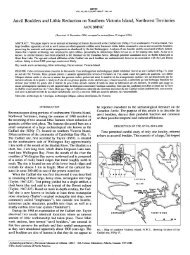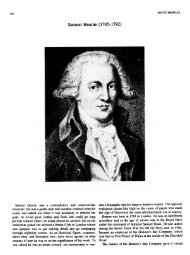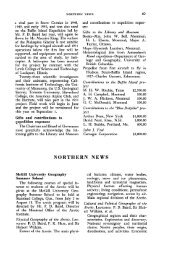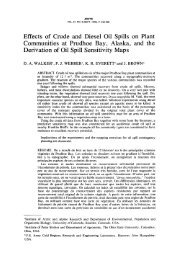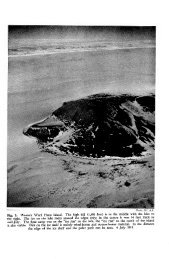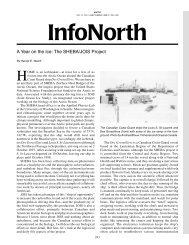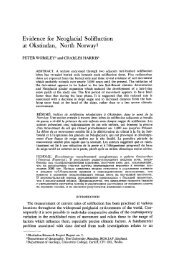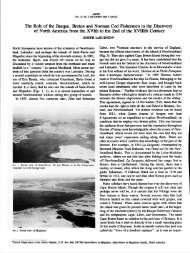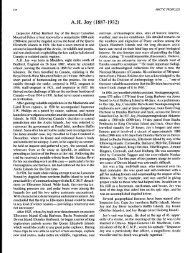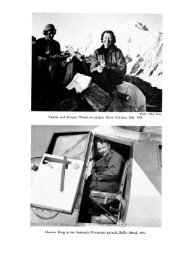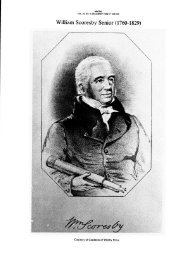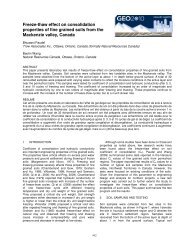Natkusiak (ca. 1885-1947)
Natkusiak (ca. 1885-1947)
Natkusiak (ca. 1885-1947)
Create successful ePaper yourself
Turn your PDF publications into a flip-book with our unique Google optimized e-Paper software.
ARCTIC PROFILES / 91<br />
<strong>Natkusiak</strong> was also affected but was able to stagger against the<br />
door to break the snow blocks, thus allowing fresh air to enter<br />
(Hunt, 198652).<br />
The Stefansson-Anderson Expedition was followed by the<br />
well-known Canadian Arctic Expedition of 1913-18, one of<br />
the largest multidisciplinary arctic expeditions ever sponsored<br />
by the Canadian government. The expedition was divided into<br />
a southern party based at Bernard Harbor and a northern party<br />
based at Cape Kellet on Banks Island. The northern party,<br />
which included <strong>Natkusiak</strong> and a number of other Inuit guides,<br />
was responsible for collecting scientific data from the regions<br />
north of Coronation Gulf.<br />
During this expedition <strong>Natkusiak</strong> made the acquaintance of<br />
anthropologist Diamond Jenness, the official ethnologist for<br />
the expedition. Jenness also did linguistic work with <strong>Natkusiak</strong><br />
and considered him to be more adventurous and selfreliant<br />
than other Inuit he had met. While members of the<br />
expedition were in winter quarters at Camden Bay, Alaska, in<br />
1913, <strong>Natkusiak</strong> spent most of the winter by himself at an isolated<br />
trapping <strong>ca</strong>mp miles from his nearest neighbor. During a<br />
visit to his <strong>ca</strong>mp later that winter, Jenness expressed surprise<br />
over the fact that <strong>Natkusiak</strong> was able to cook his own food,<br />
patch his boots, sew rips in his clothing, and maintain his<br />
dwelling without the assistance of a wife. Jenness speculated<br />
at the time that it was <strong>Natkusiak</strong>’s incredible wanderlust that<br />
accounted for his “celibacy” (Jenness, 1957: 142).<br />
During the Canadian Arctic Expedition, Stefansson and<br />
<strong>Natkusiak</strong>, usually travelling together but oc<strong>ca</strong>sionally separately,<br />
wandered extensively throughout the northern regions<br />
of Copper Inuit territory, making repeated contacts with the<br />
Copper Inuit of Prince Albert Sound, Minto Inlet, and Banks<br />
Island. (See Stefansson, 1922, for a detailed description of the<br />
Canadian Arctic Expedition.)<br />
One of the other Inuit guides of the northern part was<br />
Freeman Alingnak, who was accompanied by his wife, Minnie<br />
Kuninana, and an adopted daughter, Ikiuna, a girl of approximately<br />
10 or 12 years of age in 1916 whose father was an<br />
unknown black whaleman. According to one of <strong>Natkusiak</strong>’s<br />
daughters, Agnes Nanogak Goose, <strong>Natkusiak</strong> took Ikiuna (also<br />
known as Topsy) as a wife sometime during their stay on<br />
Melville Island. After two earlier “marriages” (the first ended<br />
with the death of <strong>Natkusiak</strong>’s wife as a result of an epidemic<br />
and the second, to a Coppermine woman, Kaodloak, ended in<br />
a separation), this marriage would see <strong>Natkusiak</strong> through the<br />
rest of his life and result in a large number of children.<br />
At the end of the Canadian Arctic Expedition, <strong>Natkusiak</strong><br />
received one of the expedition’s schooners, the North Star, as<br />
payment for services rendered. <strong>Natkusiak</strong>, Ikiuna, and a number<br />
of other Inuit who had worked for the expedition remained<br />
on Banks Island for four winters trapping white foxes. When<br />
the party left Banks Island in 1921, they had managed to <strong>ca</strong>tch<br />
approximately 1000 white foxes, an impressive number given<br />
the high prices offered for furs in the 1920s.<br />
<strong>Natkusiak</strong> and his fellow trappers had thus established the<br />
productivity of Banks Island as a trapping area. This discovery<br />
eventually resulted in a migration of trappers from the mainland<br />
to Banks Island when competition from white trappers<br />
and a noticeable decrease in fur-bearing populations on the<br />
mainland forced many of these trappers to look elsewhere for<br />
new trapping areas. <strong>Natkusiak</strong>’s discovery, which also<br />
accounts for his nickname Billy Banksland, was instrumental<br />
in leading to the formation of the Banks Island schooner fleet<br />
and the colonization of Banks Island, with temporary winter<br />
trapping <strong>ca</strong>mps as people from the Delta crossed over to the<br />
island with their schooners in fall in order to spend the winter<br />
trapping there.<br />
Throughout the 1930s and 1940s, the Banks Island<br />
schooner fleet increased in size and even started exploiting<br />
trapping areas on Victoria Island, where the western Inuit trappers<br />
<strong>ca</strong>me into repeated contact with the Copper Inuit of<br />
northwestern Victoria Island (see Usher, 1971, for a detailed<br />
description of the colonization of Banks Island).<br />
For a time after returning from Banks Island, <strong>Natkusiak</strong><br />
lived at Baillie Island. <strong>Natkusiak</strong>’s oldest surviving son,<br />
Jimmy Memorana, was adopted at about this time, when a flu<br />
epidemic killed Jimmy’s parents along with a large number of<br />
other people. Jimmy remembers that <strong>Natkusiak</strong> had a great<br />
number of material possessions, including an impressive arsenal<br />
of firearms that he had inherited from the Canadian Arctic<br />
Expedition. It was at about this time that the North Star was<br />
wrecked in a storm at Baillie Island.<br />
Around 1932-33, <strong>Natkusiak</strong> moved his family to Banks<br />
Island for the winter. The following spring, ice prevented their<br />
return to the mainland, so <strong>Natkusiak</strong> decided to sail to Victoria<br />
Island aboard Fred Bennet Ningasik’s schooner, Shamrock. the<br />
Since <strong>Natkusiak</strong> had travelled all over much of western<br />
Victoria Island, he knew the land almost as intimately as the<br />
Copper Inuit themselves. <strong>Natkusiak</strong> ended up spending the<br />
winter of 1933-34 at Ulukhaktok, which would later become<br />
the permanent settlement site of Holman. Two other ships, the<br />
Blue Fox and the Shamrock, wintered at this lo<strong>ca</strong>tion as well.<br />
In the spring, <strong>Natkusiak</strong> and his family travelled north to<br />
Walker Bay (the lo<strong>ca</strong>tion of the closest trading posts, the<br />
Hudson’s Bay Company post and the Canalaska Trading<br />
Company post) aboard David Pirktuqana’s schooner, the Sea<br />
Otter. During this time, <strong>Natkusiak</strong> appears to have divided his<br />
time between Walker Bay, Tuktoyaktuk, and Banks Island.<br />
When <strong>Natkusiak</strong>’s daughter Mary Nerlek married David<br />
Bernhardt, <strong>Natkusiak</strong> and his family started to spend more<br />
time travelling aboard Bernhardt’s ship, the Okpik. For a time,<br />
<strong>Natkusiak</strong> lived at Walker Bay, where he worked for the<br />
Canalaska post. <strong>Natkusiak</strong>’s children report that he had a job<br />
up there but <strong>ca</strong>nnot recollect how long they stayed.<br />
George Burnham, a Hudson’s Bay Company clerk who<br />
worked at the Walker Bay HBC store (Fort Collinson) during<br />
the winter of 1934-35, states that <strong>Natkusiak</strong> was a frequent<br />
visitor to the post during the winter of 1935. In his published<br />
memoirs, Burnham states:<br />
Another of our regulars was Billie Banksland who was somewhat<br />
taller than the usual Inuit. He had worked with the<br />
Stefansson expedition of 1914-1917 [sic] and was very well<br />
known and highly respected all along the coast. One of his<br />
favorite tricks on meeting someone “new” was to dress up in a<br />
complete outfit of polar bear skin, sneak up behind the unsuspecting<br />
stranger and grab him with a big bear hug. Naturally,<br />
the visitor would look down to see who or what was holding<br />
him and all he would see would be what appeared to be the<br />
feet of a bear - imagine his surprise and shock! Billie would<br />
then release his <strong>ca</strong>ptive and burst into loud laughter accompanied<br />
by whoever else was present [Burnham, 1986:129-1301.<br />
Others have noted <strong>Natkusiak</strong>’s fine sense of humor: Diamond<br />
Jenness commented that <strong>Natkusiak</strong> “was a cheerful fellow who<br />
always seemed easy to get along with, rather happy-go-lucky<br />
indeed, with a twinkle always lurking in his dark brown eyes”<br />
(Jenness, 1957:142). At one point, <strong>Natkusiak</strong> admitted to<br />
Jenness that he had posed as a great magician while travelling



